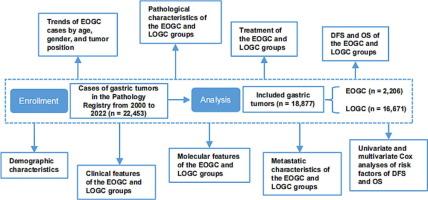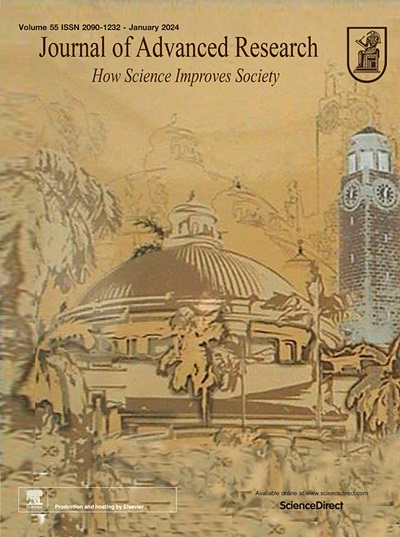Trends, clinicopathological features, surgical treatment patterns and prognoses of early-onset versus late-onset gastric cancer: A retrospective cohort study
IF 11.4
1区 综合性期刊
Q1 MULTIDISCIPLINARY SCIENCES
引用次数: 0
Abstract
Introduction
This study investigates the differences between early-onset gastric carcinoma (EOGC) and late-onset gastric carcinoma (LOGC) by examining trends, demographics, clinical and molecular features, treatments, and outcomes at a leading cancer center in China.Objectives
To delineate the distinctions between EOGC and LOGC in terms of patient characteristics, disease progression, and treatment outcomes, and to suggest appropriate screening strategies.Methods
We analyzed 18,877 gastric carcinoma cases treated at Fudan University Shanghai Cancer Center (FUSCC) from 2000 to 2022. Descriptive statistics were performed using IBM SPSS. Survival rates were assessed via the Kaplan-Meier method and log-rank test, while COX regression analysis identified factors affecting disease-free survival (DFS) and overall survival (OS).Results
The average age of gastric cancer diagnosis has increased slightly since 2000, with a steady rise in both EOGC and LOGC cases, though EOGC’s proportion has slightly decreased. EOGC had a higher proportion of female patients and was more common in the gastric body and antrum pylorus. EOGC cases showed lower levels of cancer biomarkers, HER2 expression, vascular and lymphatic invasion, and lower differentiation and invasion depth. They also exhibited more advanced N and TNM staging, Borrmann IV type, and low adhesive carcinoma. EOGC underwent more extensive D2 lymphadenectomy and neoadjuvant chemotherapy. There were no significant differences in Claudin18.2 and MMR protein status between EOGC and LOGC. EOGC had higher rates of ovarian and peritoneal metastases, with a better early prognosis but faster late-stage progression.Conclusion
EOGC and LOGC cases have increased over the past two decades. EOGC presents unique clinical and pathological features, requiring thorough surgical treatment and has a better early prognosis but more rapid late-stage progression. Enhanced screening for younger adults is recommended to address the rising EOGC trend.

早发与晚发胃癌的发展趋势、临床病理特征、手术治疗模式和预后:回顾性队列研究
导言本研究通过研究中国一家领先癌症中心的趋势、人口统计学、临床和分子特征、治疗和结果,探讨了早发性胃癌(EOGC)和晚发性胃癌(LOGC)之间的差异。方法 我们分析了复旦大学上海肿瘤防治中心(FUSCC)自2000年至2022年收治的18877例胃癌病例。采用IBM SPSS进行描述性统计。结果自2000年以来,胃癌诊断的平均年龄略有增加,EOGC和LOGC病例均稳步上升,但EOGC所占比例略有下降。EOGC女性患者比例较高,在胃体和幽门前部更为常见。EOGC病例的癌症生物标志物、HER2表达、血管和淋巴侵袭水平较低,分化和侵袭深度也较低。他们还表现出更晚期的N和TNM分期、Borrmann IV型和低粘着性癌。EOGC 接受了更广泛的 D2 淋巴腺切除术和新辅助化疗。EOGC和LOGC的Claudin18.2和MMR蛋白状态无明显差异。EOGC的卵巢和腹膜转移率较高,早期预后较好,但晚期进展较快。EOGC具有独特的临床和病理特征,需要彻底的手术治疗,早期预后较好,但晚期进展较快。建议加强对年轻成年人的筛查,以应对 EOGC 的上升趋势。
本文章由计算机程序翻译,如有差异,请以英文原文为准。
求助全文
约1分钟内获得全文
求助全文
来源期刊

Journal of Advanced Research
Multidisciplinary-Multidisciplinary
CiteScore
21.60
自引率
0.90%
发文量
280
审稿时长
12 weeks
期刊介绍:
Journal of Advanced Research (J. Adv. Res.) is an applied/natural sciences, peer-reviewed journal that focuses on interdisciplinary research. The journal aims to contribute to applied research and knowledge worldwide through the publication of original and high-quality research articles in the fields of Medicine, Pharmaceutical Sciences, Dentistry, Physical Therapy, Veterinary Medicine, and Basic and Biological Sciences.
The following abstracting and indexing services cover the Journal of Advanced Research: PubMed/Medline, Essential Science Indicators, Web of Science, Scopus, PubMed Central, PubMed, Science Citation Index Expanded, Directory of Open Access Journals (DOAJ), and INSPEC.
 求助内容:
求助内容: 应助结果提醒方式:
应助结果提醒方式:


